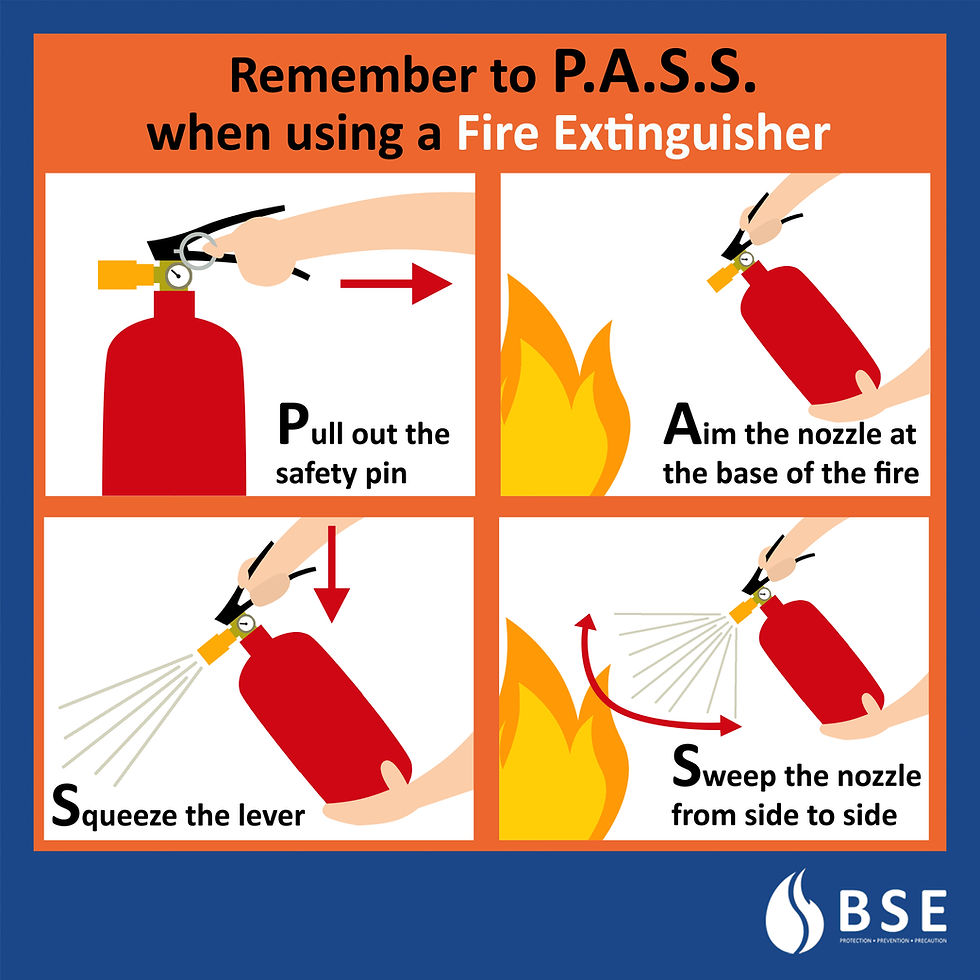The Portable Fire Extinguisher—a Lifeline in Your Hands
- BSE

- Jun 18, 2019
- 3 min read
Updated: Sep 8, 2019

When a fire breaks out and the spread is still containable, the immediate fire-fighting response equipment is the Portable Fire Extinguisher. But would you know what to do if you had the chance to take action?
Located within common areas of building facilities (in a Fire Extinguisher Cabinet or within a Duct), key areas within a tenanted unit or near exits, the Portable Fire Extinguisher is a common sight as it has to be accessible at all times.
To use a Portable Fire Extinguisher, remember the P.A.S.S. rule:
Pull the pin at the top of the Fire Extinguisher
Aim the nozzle towards the base of the fire
Squeeze the handle to discharge
Sweep the nozzle from side to side
Is it mandatory to have one in a building? Is it necessary to know how to use one? Yes to both. When this fire-fighting equipment is used by a person prepared for such situations, it could save lives and properties, including his/her own. The following regulations thus require premises to have an operationally-ready and well-maintained Portable Fire Extinguisher:
Code of Practice for Fire Safety Precautions in Buildings
Code of Practice for Use and Maintenance of Portable Fire Extinguishers (SS 578: 2012)
Who is responsible for the Portable Fire Extinguisher?
Building Owners and Council Members are responsible by regulation
Fire Protection Specialists, like BSE, MCST Managing agencies, and/ or technicians are engaged to assist Building Owners and Council Members
Tenants of owned or rented units are responsible for their own equipment within the unit.
Basic features of the Portable Fire Extinguisher
There are two types of fire extinguishers: Portable (commonly seen and used) and Fixed Installation System.
The different types of Portable Fire Extinguisher:
Dry Powder (Red with Blue, for older versions - Blue)
Carbon Dioxide (Red with Black, for older versions - Black)
Water (Red)
Clean Agent/ Halogenated (Red with Green, for older versions - Green)
Water Mist (White and Red)
Foam (Red and Cream)
Wet Chemical (Red with Yellow)
Dry Chemical (Red with Blue)
Others
*NOTICE: Update of regulation
Before 1 May 2013, all Dry Powder Fire Extinguishers (“ABC” Blue Cylinder Types) are still usable provided that the Certificate of Conformity (COC) from the Manufacturer is still valid.
Otherwise, any Fire Extinguisher with the “C” rating is to be removed as it does not comply with the regulatory tests (based on Code of Practice SS 578: 2012 version) to be conducted for it.
After 1 May 2013, all Dry Powder Fire Extinguishers and other types are to comply with the Code of Practice SS 578: 2012 version (“AB” Red Cylinder Types for Dry Powder Types and others accordingly).
What kind of maintenance will the Portable Fire Extinguisher need and how often?
According to regulations, the common frequency of inspection of the Portable Fire Extinguishers in buildings is MONTHLY. However, the regulatory testing and maintenance of the Portable Fire Extinguishers are conducted ANNUALLY.
For industrial buildings with higher risk of fire incidents, more frequent testing and maintenance may be conducted to ensure Total Fire Safety in the premises.
Inspection procedure
Inspection checklist for the Portable Fire Extinguisher:
Located at its designated place
No obstruction of accessibility or visibility
Operating instructions on the label are seen legibly
Safety seals are not tampered with
Gauge reading (for some types of fire extinguishers) indicates it is in operative range
No physical damage, corrosion, leakage or clogged nozzles
Fire extinguisher cabinet/ wall hook bracket
Service Label by Authorized Companies to revalidate the Portable Fire Extinguisher
Testing procedure
Portable Fire Extinguishers are tested by
servicing on-site to determine fullness by weighing or hefting
servicing in the workshop for hydrostatic/ hydraulic testing of the cylinder based on manufacturers’ requirements
Next, defects are identified for recommendation and rectified in a timely manner.
Tips on having an optimum Portable Fire Extinguisher:
Ensure that your PORTABLE FIRE EXTINGUISHER has been SERVICED and is in GOOD WORKING CONDITION
Ensure that it is VISIBLE AND ACCESSIBLE for use when required
Ensure that LOAN or REPLACEMENT PORTABLE FIRE EXTINGUISHERS (of similar capacity and rating) are on-site FOR PORTABLE FIRE EXTINGUISHERS THAT HAVE BEEN BROUGHT BACK FOR MAINTENANCE at the AUTHORIZED WORKSHOPS by THE SINGAPORE CIVIL DEFENCE FORCE (SCDF)




Comments